Management Accounting Report: Techniques, Integration and Benefits
VerifiedAdded on 2023/06/08
|15
|4401
|433
Report
AI Summary
This report provides a comprehensive overview of management accounting, encompassing its core principles, roles, and the techniques employed within a business context. The report delves into the significance of management accounting in identifying, measuring, and interpreting financial data to achieve organizational goals. It explores the application of various techniques, including marginal costing and absorption costing, through practical examples. The report further examines the integration of management accounting within an organization, highlighting the benefits it offers, such as improved decision-making and cost management. Additionally, it compares and contrasts different planning tools used in management accounting and evaluates their effectiveness in addressing financial challenges. The report emphasizes the role of management accounting in both short-term and long-term planning, financial record-keeping, and capital structure maintenance. The report concludes by reflecting on the practical application of management accounting principles and the importance of continuous improvement and quality management.
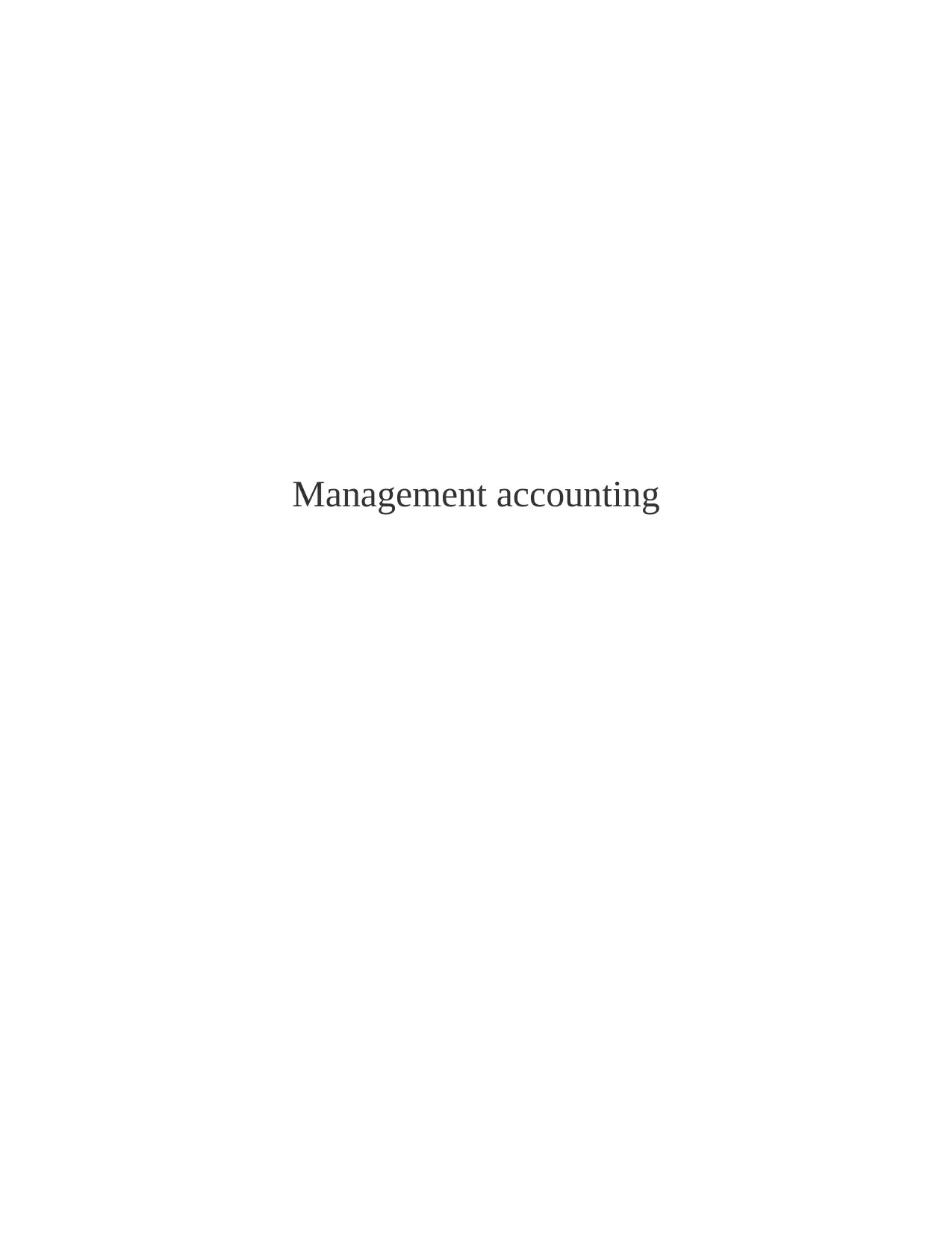
Management accounting
Paraphrase This Document
Need a fresh take? Get an instant paraphrase of this document with our AI Paraphraser
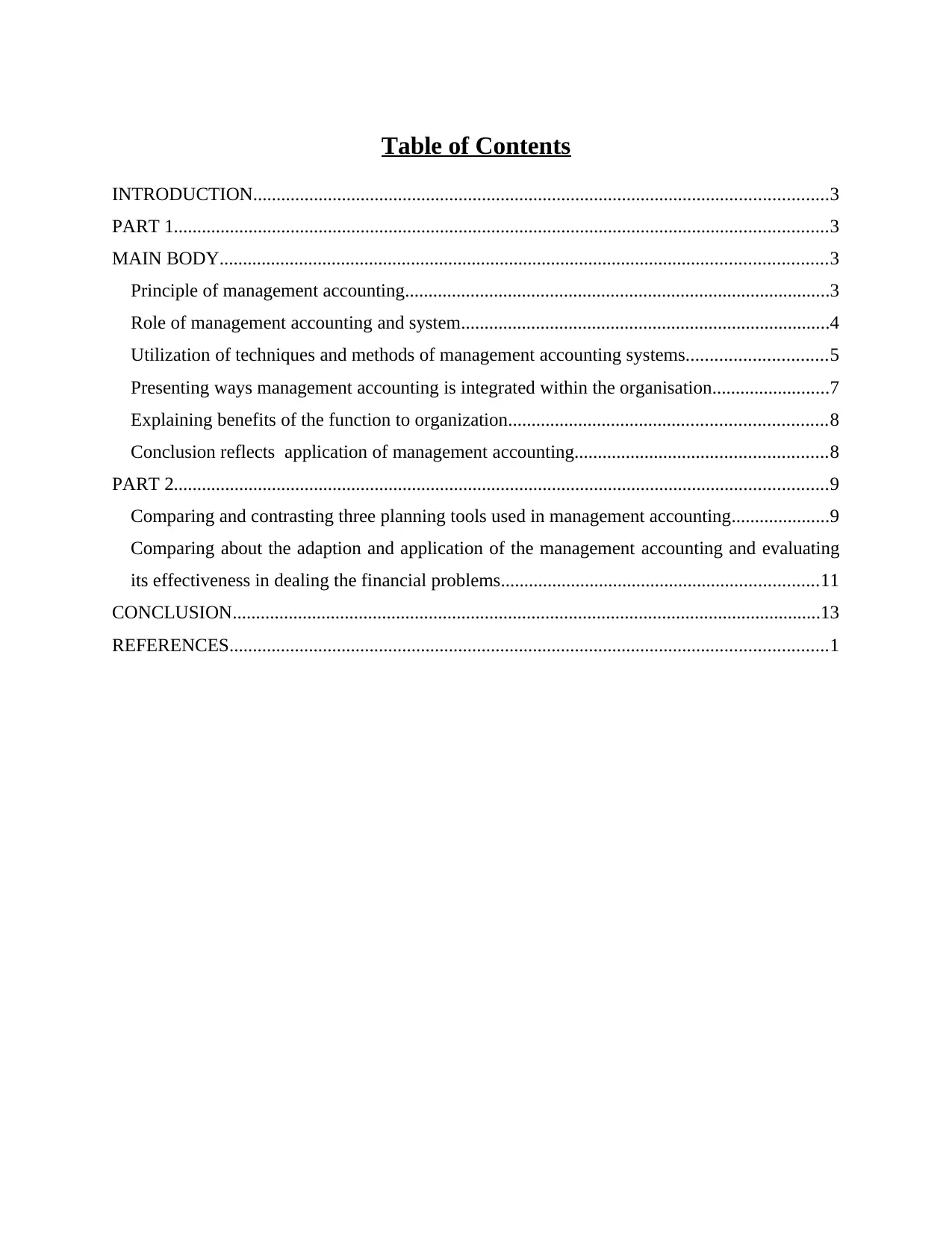
Table of Contents
INTRODUCTION...........................................................................................................................3
PART 1............................................................................................................................................3
MAIN BODY..................................................................................................................................3
Principle of management accounting...........................................................................................3
Role of management accounting and system...............................................................................4
Utilization of techniques and methods of management accounting systems..............................5
Presenting ways management accounting is integrated within the organisation.........................7
Explaining benefits of the function to organization....................................................................8
Conclusion reflects application of management accounting......................................................8
PART 2............................................................................................................................................9
Comparing and contrasting three planning tools used in management accounting.....................9
Comparing about the adaption and application of the management accounting and evaluating
its effectiveness in dealing the financial problems....................................................................11
CONCLUSION..............................................................................................................................13
REFERENCES................................................................................................................................1
INTRODUCTION...........................................................................................................................3
PART 1............................................................................................................................................3
MAIN BODY..................................................................................................................................3
Principle of management accounting...........................................................................................3
Role of management accounting and system...............................................................................4
Utilization of techniques and methods of management accounting systems..............................5
Presenting ways management accounting is integrated within the organisation.........................7
Explaining benefits of the function to organization....................................................................8
Conclusion reflects application of management accounting......................................................8
PART 2............................................................................................................................................9
Comparing and contrasting three planning tools used in management accounting.....................9
Comparing about the adaption and application of the management accounting and evaluating
its effectiveness in dealing the financial problems....................................................................11
CONCLUSION..............................................................................................................................13
REFERENCES................................................................................................................................1
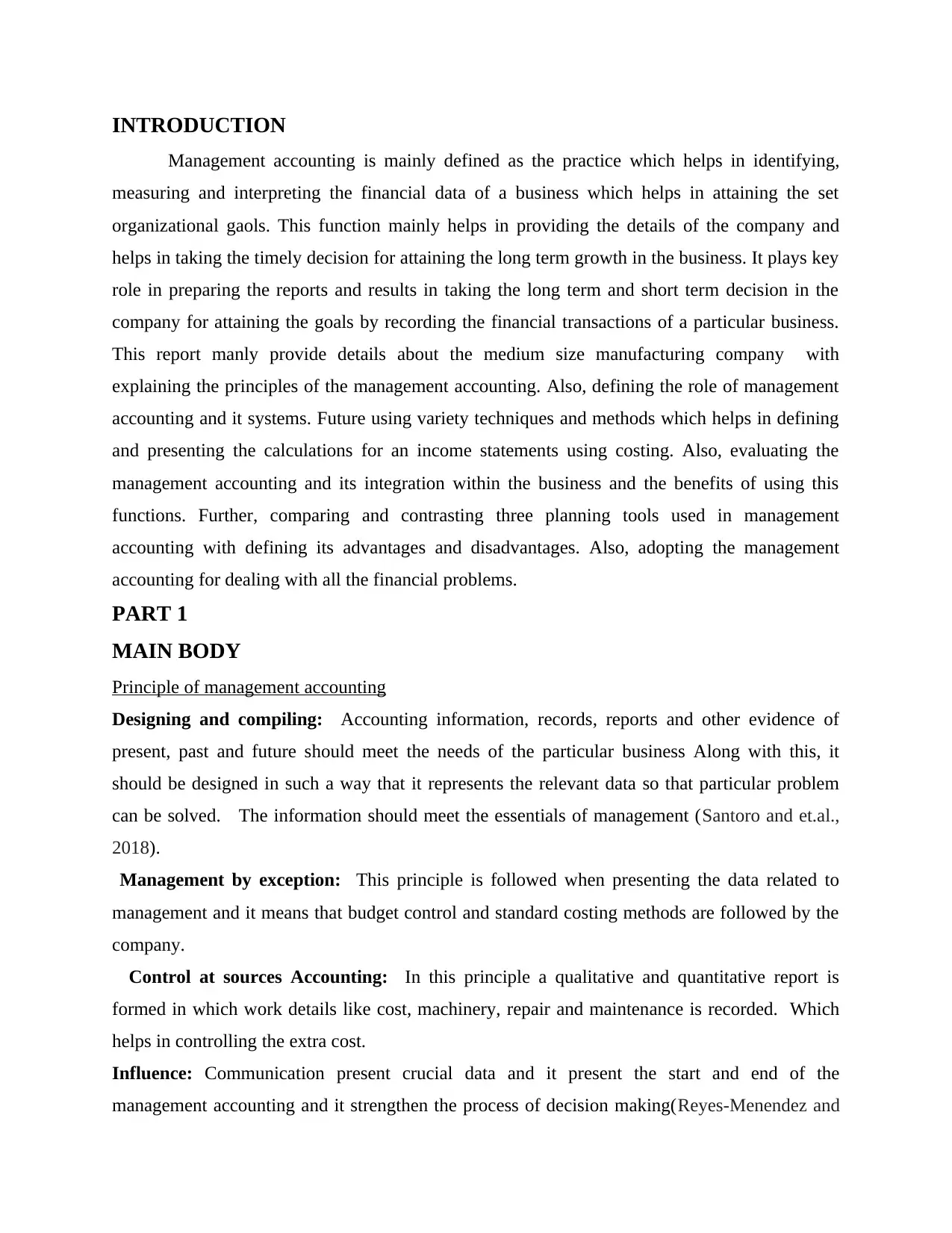
INTRODUCTION
Management accounting is mainly defined as the practice which helps in identifying,
measuring and interpreting the financial data of a business which helps in attaining the set
organizational gaols. This function mainly helps in providing the details of the company and
helps in taking the timely decision for attaining the long term growth in the business. It plays key
role in preparing the reports and results in taking the long term and short term decision in the
company for attaining the goals by recording the financial transactions of a particular business.
This report manly provide details about the medium size manufacturing company with
explaining the principles of the management accounting. Also, defining the role of management
accounting and it systems. Future using variety techniques and methods which helps in defining
and presenting the calculations for an income statements using costing. Also, evaluating the
management accounting and its integration within the business and the benefits of using this
functions. Further, comparing and contrasting three planning tools used in management
accounting with defining its advantages and disadvantages. Also, adopting the management
accounting for dealing with all the financial problems.
PART 1
MAIN BODY
Principle of management accounting
Designing and compiling: Accounting information, records, reports and other evidence of
present, past and future should meet the needs of the particular business Along with this, it
should be designed in such a way that it represents the relevant data so that particular problem
can be solved. The information should meet the essentials of management (Santoro and et.al.,
2018).
Management by exception: This principle is followed when presenting the data related to
management and it means that budget control and standard costing methods are followed by the
company.
Control at sources Accounting: In this principle a qualitative and quantitative report is
formed in which work details like cost, machinery, repair and maintenance is recorded. Which
helps in controlling the extra cost.
Influence: Communication present crucial data and it present the start and end of the
management accounting and it strengthen the process of decision making(Reyes-Menendez and
Management accounting is mainly defined as the practice which helps in identifying,
measuring and interpreting the financial data of a business which helps in attaining the set
organizational gaols. This function mainly helps in providing the details of the company and
helps in taking the timely decision for attaining the long term growth in the business. It plays key
role in preparing the reports and results in taking the long term and short term decision in the
company for attaining the goals by recording the financial transactions of a particular business.
This report manly provide details about the medium size manufacturing company with
explaining the principles of the management accounting. Also, defining the role of management
accounting and it systems. Future using variety techniques and methods which helps in defining
and presenting the calculations for an income statements using costing. Also, evaluating the
management accounting and its integration within the business and the benefits of using this
functions. Further, comparing and contrasting three planning tools used in management
accounting with defining its advantages and disadvantages. Also, adopting the management
accounting for dealing with all the financial problems.
PART 1
MAIN BODY
Principle of management accounting
Designing and compiling: Accounting information, records, reports and other evidence of
present, past and future should meet the needs of the particular business Along with this, it
should be designed in such a way that it represents the relevant data so that particular problem
can be solved. The information should meet the essentials of management (Santoro and et.al.,
2018).
Management by exception: This principle is followed when presenting the data related to
management and it means that budget control and standard costing methods are followed by the
company.
Control at sources Accounting: In this principle a qualitative and quantitative report is
formed in which work details like cost, machinery, repair and maintenance is recorded. Which
helps in controlling the extra cost.
Influence: Communication present crucial data and it present the start and end of the
management accounting and it strengthen the process of decision making(Reyes-Menendez and
⊘ This is a preview!⊘
Do you want full access?
Subscribe today to unlock all pages.

Trusted by 1+ million students worldwide
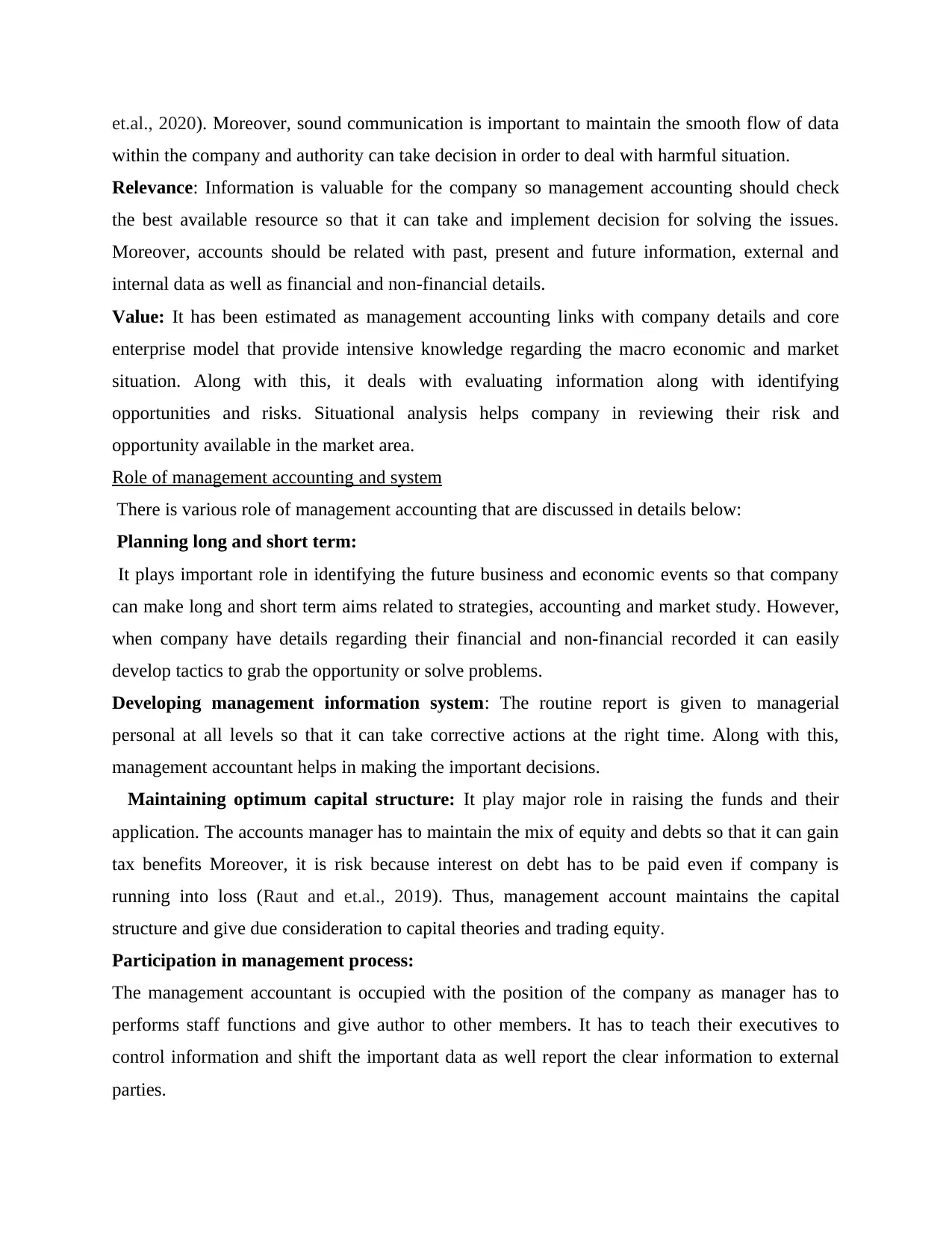
et.al., 2020). Moreover, sound communication is important to maintain the smooth flow of data
within the company and authority can take decision in order to deal with harmful situation.
Relevance: Information is valuable for the company so management accounting should check
the best available resource so that it can take and implement decision for solving the issues.
Moreover, accounts should be related with past, present and future information, external and
internal data as well as financial and non-financial details.
Value: It has been estimated as management accounting links with company details and core
enterprise model that provide intensive knowledge regarding the macro economic and market
situation. Along with this, it deals with evaluating information along with identifying
opportunities and risks. Situational analysis helps company in reviewing their risk and
opportunity available in the market area.
Role of management accounting and system
There is various role of management accounting that are discussed in details below:
Planning long and short term:
It plays important role in identifying the future business and economic events so that company
can make long and short term aims related to strategies, accounting and market study. However,
when company have details regarding their financial and non-financial recorded it can easily
develop tactics to grab the opportunity or solve problems.
Developing management information system: The routine report is given to managerial
personal at all levels so that it can take corrective actions at the right time. Along with this,
management accountant helps in making the important decisions.
Maintaining optimum capital structure: It play major role in raising the funds and their
application. The accounts manager has to maintain the mix of equity and debts so that it can gain
tax benefits Moreover, it is risk because interest on debt has to be paid even if company is
running into loss (Raut and et.al., 2019). Thus, management account maintains the capital
structure and give due consideration to capital theories and trading equity.
Participation in management process:
The management accountant is occupied with the position of the company as manager has to
performs staff functions and give author to other members. It has to teach their executives to
control information and shift the important data as well report the clear information to external
parties.
within the company and authority can take decision in order to deal with harmful situation.
Relevance: Information is valuable for the company so management accounting should check
the best available resource so that it can take and implement decision for solving the issues.
Moreover, accounts should be related with past, present and future information, external and
internal data as well as financial and non-financial details.
Value: It has been estimated as management accounting links with company details and core
enterprise model that provide intensive knowledge regarding the macro economic and market
situation. Along with this, it deals with evaluating information along with identifying
opportunities and risks. Situational analysis helps company in reviewing their risk and
opportunity available in the market area.
Role of management accounting and system
There is various role of management accounting that are discussed in details below:
Planning long and short term:
It plays important role in identifying the future business and economic events so that company
can make long and short term aims related to strategies, accounting and market study. However,
when company have details regarding their financial and non-financial recorded it can easily
develop tactics to grab the opportunity or solve problems.
Developing management information system: The routine report is given to managerial
personal at all levels so that it can take corrective actions at the right time. Along with this,
management accountant helps in making the important decisions.
Maintaining optimum capital structure: It play major role in raising the funds and their
application. The accounts manager has to maintain the mix of equity and debts so that it can gain
tax benefits Moreover, it is risk because interest on debt has to be paid even if company is
running into loss (Raut and et.al., 2019). Thus, management account maintains the capital
structure and give due consideration to capital theories and trading equity.
Participation in management process:
The management accountant is occupied with the position of the company as manager has to
performs staff functions and give author to other members. It has to teach their executives to
control information and shift the important data as well report the clear information to external
parties.
Paraphrase This Document
Need a fresh take? Get an instant paraphrase of this document with our AI Paraphraser
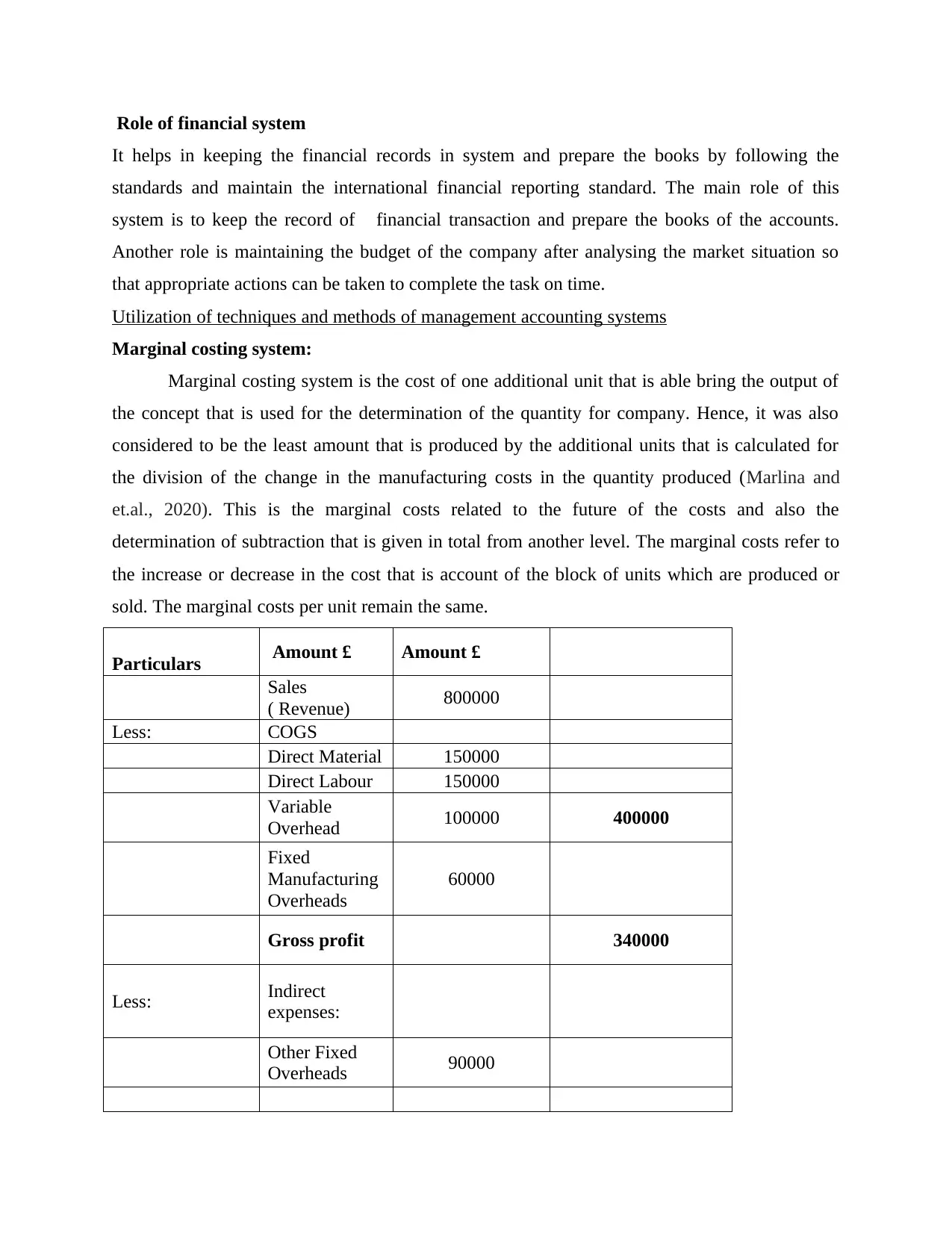
Role of financial system
It helps in keeping the financial records in system and prepare the books by following the
standards and maintain the international financial reporting standard. The main role of this
system is to keep the record of financial transaction and prepare the books of the accounts.
Another role is maintaining the budget of the company after analysing the market situation so
that appropriate actions can be taken to complete the task on time.
Utilization of techniques and methods of management accounting systems
Marginal costing system:
Marginal costing system is the cost of one additional unit that is able bring the output of
the concept that is used for the determination of the quantity for company. Hence, it was also
considered to be the least amount that is produced by the additional units that is calculated for
the division of the change in the manufacturing costs in the quantity produced (Marlina and
et.al., 2020). This is the marginal costs related to the future of the costs and also the
determination of subtraction that is given in total from another level. The marginal costs refer to
the increase or decrease in the cost that is account of the block of units which are produced or
sold. The marginal costs per unit remain the same.
Amount £ Amount £
Particulars
Sales
( Revenue) 800000
Less: COGS
Direct Material 150000
Direct Labour 150000
Variable
Overhead 100000 400000
Fixed
Manufacturing
Overheads
60000
Gross profit 340000
Less: Indirect
expenses:
Other Fixed
Overheads 90000
It helps in keeping the financial records in system and prepare the books by following the
standards and maintain the international financial reporting standard. The main role of this
system is to keep the record of financial transaction and prepare the books of the accounts.
Another role is maintaining the budget of the company after analysing the market situation so
that appropriate actions can be taken to complete the task on time.
Utilization of techniques and methods of management accounting systems
Marginal costing system:
Marginal costing system is the cost of one additional unit that is able bring the output of
the concept that is used for the determination of the quantity for company. Hence, it was also
considered to be the least amount that is produced by the additional units that is calculated for
the division of the change in the manufacturing costs in the quantity produced (Marlina and
et.al., 2020). This is the marginal costs related to the future of the costs and also the
determination of subtraction that is given in total from another level. The marginal costs refer to
the increase or decrease in the cost that is account of the block of units which are produced or
sold. The marginal costs per unit remain the same.
Amount £ Amount £
Particulars
Sales
( Revenue) 800000
Less: COGS
Direct Material 150000
Direct Labour 150000
Variable
Overhead 100000 400000
Fixed
Manufacturing
Overheads
60000
Gross profit 340000
Less: Indirect
expenses:
Other Fixed
Overheads 90000
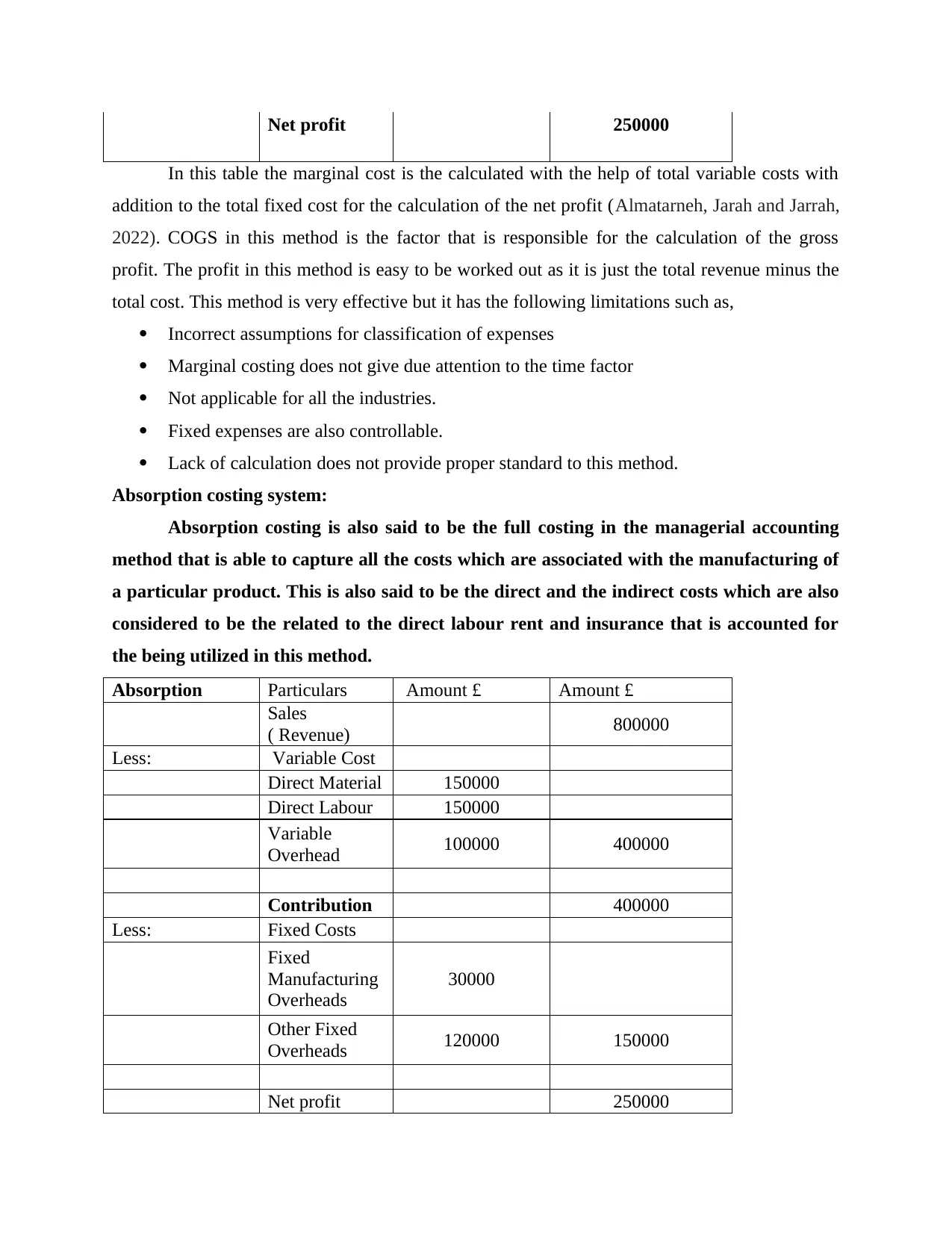
Net profit 250000
In this table the marginal cost is the calculated with the help of total variable costs with
addition to the total fixed cost for the calculation of the net profit (Almatarneh, Jarah and Jarrah,
2022). COGS in this method is the factor that is responsible for the calculation of the gross
profit. The profit in this method is easy to be worked out as it is just the total revenue minus the
total cost. This method is very effective but it has the following limitations such as,
Incorrect assumptions for classification of expenses
Marginal costing does not give due attention to the time factor
Not applicable for all the industries.
Fixed expenses are also controllable.
Lack of calculation does not provide proper standard to this method.
Absorption costing system:
Absorption costing is also said to be the full costing in the managerial accounting
method that is able to capture all the costs which are associated with the manufacturing of
a particular product. This is also said to be the direct and the indirect costs which are also
considered to be the related to the direct labour rent and insurance that is accounted for
the being utilized in this method.
Absorption Particulars Amount £ Amount £
Sales
( Revenue) 800000
Less: Variable Cost
Direct Material 150000
Direct Labour 150000
Variable
Overhead 100000 400000
Contribution 400000
Less: Fixed Costs
Fixed
Manufacturing
Overheads
30000
Other Fixed
Overheads 120000 150000
Net profit 250000
In this table the marginal cost is the calculated with the help of total variable costs with
addition to the total fixed cost for the calculation of the net profit (Almatarneh, Jarah and Jarrah,
2022). COGS in this method is the factor that is responsible for the calculation of the gross
profit. The profit in this method is easy to be worked out as it is just the total revenue minus the
total cost. This method is very effective but it has the following limitations such as,
Incorrect assumptions for classification of expenses
Marginal costing does not give due attention to the time factor
Not applicable for all the industries.
Fixed expenses are also controllable.
Lack of calculation does not provide proper standard to this method.
Absorption costing system:
Absorption costing is also said to be the full costing in the managerial accounting
method that is able to capture all the costs which are associated with the manufacturing of
a particular product. This is also said to be the direct and the indirect costs which are also
considered to be the related to the direct labour rent and insurance that is accounted for
the being utilized in this method.
Absorption Particulars Amount £ Amount £
Sales
( Revenue) 800000
Less: Variable Cost
Direct Material 150000
Direct Labour 150000
Variable
Overhead 100000 400000
Contribution 400000
Less: Fixed Costs
Fixed
Manufacturing
Overheads
30000
Other Fixed
Overheads 120000 150000
Net profit 250000
⊘ This is a preview!⊘
Do you want full access?
Subscribe today to unlock all pages.

Trusted by 1+ million students worldwide
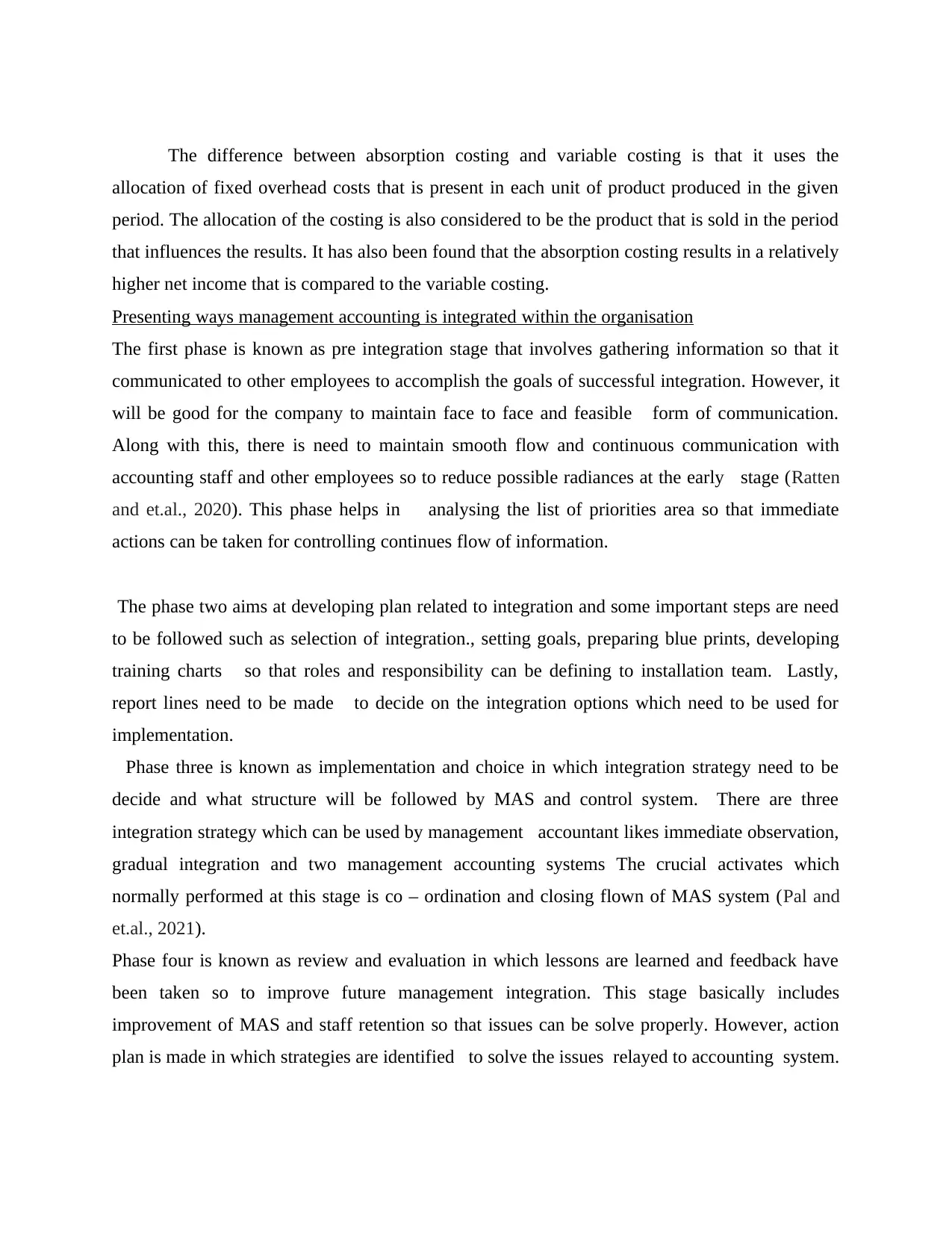
The difference between absorption costing and variable costing is that it uses the
allocation of fixed overhead costs that is present in each unit of product produced in the given
period. The allocation of the costing is also considered to be the product that is sold in the period
that influences the results. It has also been found that the absorption costing results in a relatively
higher net income that is compared to the variable costing.
Presenting ways management accounting is integrated within the organisation
The first phase is known as pre integration stage that involves gathering information so that it
communicated to other employees to accomplish the goals of successful integration. However, it
will be good for the company to maintain face to face and feasible form of communication.
Along with this, there is need to maintain smooth flow and continuous communication with
accounting staff and other employees so to reduce possible radiances at the early stage (Ratten
and et.al., 2020). This phase helps in analysing the list of priorities area so that immediate
actions can be taken for controlling continues flow of information.
The phase two aims at developing plan related to integration and some important steps are need
to be followed such as selection of integration., setting goals, preparing blue prints, developing
training charts so that roles and responsibility can be defining to installation team. Lastly,
report lines need to be made to decide on the integration options which need to be used for
implementation.
Phase three is known as implementation and choice in which integration strategy need to be
decide and what structure will be followed by MAS and control system. There are three
integration strategy which can be used by management accountant likes immediate observation,
gradual integration and two management accounting systems The crucial activates which
normally performed at this stage is co – ordination and closing flown of MAS system (Pal and
et.al., 2021).
Phase four is known as review and evaluation in which lessons are learned and feedback have
been taken so to improve future management integration. This stage basically includes
improvement of MAS and staff retention so that issues can be solve properly. However, action
plan is made in which strategies are identified to solve the issues relayed to accounting system.
allocation of fixed overhead costs that is present in each unit of product produced in the given
period. The allocation of the costing is also considered to be the product that is sold in the period
that influences the results. It has also been found that the absorption costing results in a relatively
higher net income that is compared to the variable costing.
Presenting ways management accounting is integrated within the organisation
The first phase is known as pre integration stage that involves gathering information so that it
communicated to other employees to accomplish the goals of successful integration. However, it
will be good for the company to maintain face to face and feasible form of communication.
Along with this, there is need to maintain smooth flow and continuous communication with
accounting staff and other employees so to reduce possible radiances at the early stage (Ratten
and et.al., 2020). This phase helps in analysing the list of priorities area so that immediate
actions can be taken for controlling continues flow of information.
The phase two aims at developing plan related to integration and some important steps are need
to be followed such as selection of integration., setting goals, preparing blue prints, developing
training charts so that roles and responsibility can be defining to installation team. Lastly,
report lines need to be made to decide on the integration options which need to be used for
implementation.
Phase three is known as implementation and choice in which integration strategy need to be
decide and what structure will be followed by MAS and control system. There are three
integration strategy which can be used by management accountant likes immediate observation,
gradual integration and two management accounting systems The crucial activates which
normally performed at this stage is co – ordination and closing flown of MAS system (Pal and
et.al., 2021).
Phase four is known as review and evaluation in which lessons are learned and feedback have
been taken so to improve future management integration. This stage basically includes
improvement of MAS and staff retention so that issues can be solve properly. However, action
plan is made in which strategies are identified to solve the issues relayed to accounting system.
Paraphrase This Document
Need a fresh take? Get an instant paraphrase of this document with our AI Paraphraser
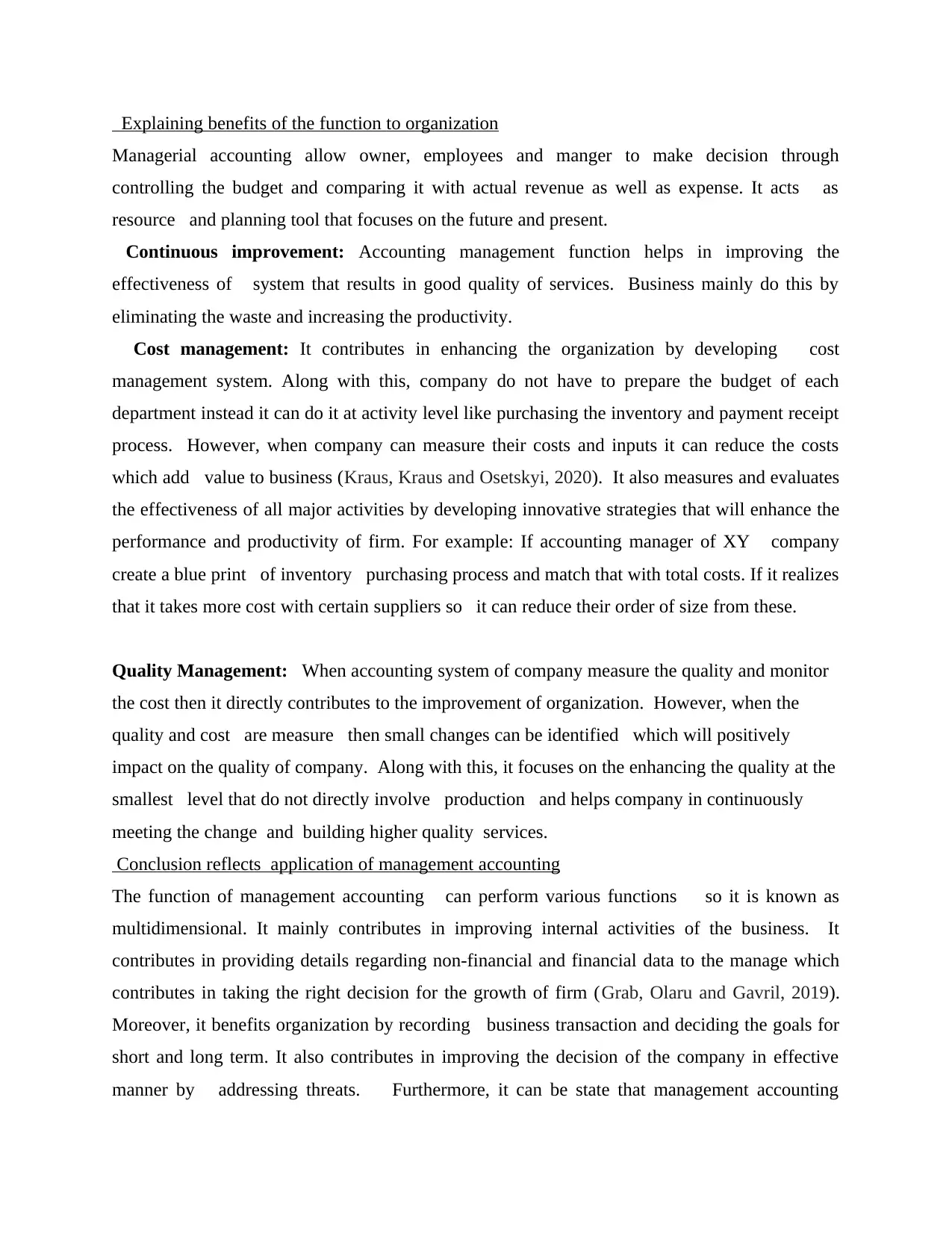
Explaining benefits of the function to organization
Managerial accounting allow owner, employees and manger to make decision through
controlling the budget and comparing it with actual revenue as well as expense. It acts as
resource and planning tool that focuses on the future and present.
Continuous improvement: Accounting management function helps in improving the
effectiveness of system that results in good quality of services. Business mainly do this by
eliminating the waste and increasing the productivity.
Cost management: It contributes in enhancing the organization by developing cost
management system. Along with this, company do not have to prepare the budget of each
department instead it can do it at activity level like purchasing the inventory and payment receipt
process. However, when company can measure their costs and inputs it can reduce the costs
which add value to business (Kraus, Kraus and Osetskyi, 2020). It also measures and evaluates
the effectiveness of all major activities by developing innovative strategies that will enhance the
performance and productivity of firm. For example: If accounting manager of XY company
create a blue print of inventory purchasing process and match that with total costs. If it realizes
that it takes more cost with certain suppliers so it can reduce their order of size from these.
Quality Management: When accounting system of company measure the quality and monitor
the cost then it directly contributes to the improvement of organization. However, when the
quality and cost are measure then small changes can be identified which will positively
impact on the quality of company. Along with this, it focuses on the enhancing the quality at the
smallest level that do not directly involve production and helps company in continuously
meeting the change and building higher quality services.
Conclusion reflects application of management accounting
The function of management accounting can perform various functions so it is known as
multidimensional. It mainly contributes in improving internal activities of the business. It
contributes in providing details regarding non-financial and financial data to the manage which
contributes in taking the right decision for the growth of firm (Grab, Olaru and Gavril, 2019).
Moreover, it benefits organization by recording business transaction and deciding the goals for
short and long term. It also contributes in improving the decision of the company in effective
manner by addressing threats. Furthermore, it can be state that management accounting
Managerial accounting allow owner, employees and manger to make decision through
controlling the budget and comparing it with actual revenue as well as expense. It acts as
resource and planning tool that focuses on the future and present.
Continuous improvement: Accounting management function helps in improving the
effectiveness of system that results in good quality of services. Business mainly do this by
eliminating the waste and increasing the productivity.
Cost management: It contributes in enhancing the organization by developing cost
management system. Along with this, company do not have to prepare the budget of each
department instead it can do it at activity level like purchasing the inventory and payment receipt
process. However, when company can measure their costs and inputs it can reduce the costs
which add value to business (Kraus, Kraus and Osetskyi, 2020). It also measures and evaluates
the effectiveness of all major activities by developing innovative strategies that will enhance the
performance and productivity of firm. For example: If accounting manager of XY company
create a blue print of inventory purchasing process and match that with total costs. If it realizes
that it takes more cost with certain suppliers so it can reduce their order of size from these.
Quality Management: When accounting system of company measure the quality and monitor
the cost then it directly contributes to the improvement of organization. However, when the
quality and cost are measure then small changes can be identified which will positively
impact on the quality of company. Along with this, it focuses on the enhancing the quality at the
smallest level that do not directly involve production and helps company in continuously
meeting the change and building higher quality services.
Conclusion reflects application of management accounting
The function of management accounting can perform various functions so it is known as
multidimensional. It mainly contributes in improving internal activities of the business. It
contributes in providing details regarding non-financial and financial data to the manage which
contributes in taking the right decision for the growth of firm (Grab, Olaru and Gavril, 2019).
Moreover, it benefits organization by recording business transaction and deciding the goals for
short and long term. It also contributes in improving the decision of the company in effective
manner by addressing threats. Furthermore, it can be state that management accounting
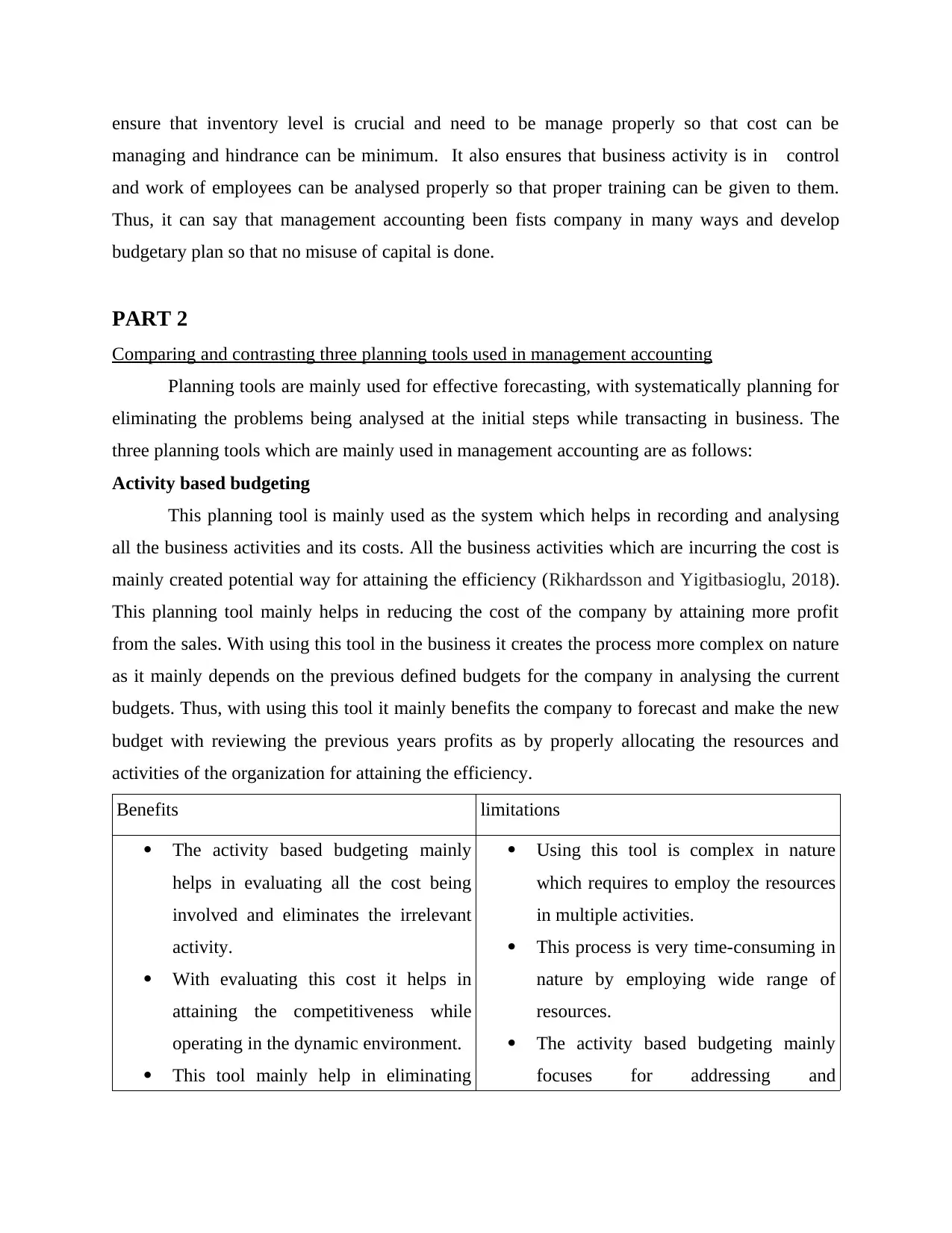
ensure that inventory level is crucial and need to be manage properly so that cost can be
managing and hindrance can be minimum. It also ensures that business activity is in control
and work of employees can be analysed properly so that proper training can be given to them.
Thus, it can say that management accounting been fists company in many ways and develop
budgetary plan so that no misuse of capital is done.
PART 2
Comparing and contrasting three planning tools used in management accounting
Planning tools are mainly used for effective forecasting, with systematically planning for
eliminating the problems being analysed at the initial steps while transacting in business. The
three planning tools which are mainly used in management accounting are as follows:
Activity based budgeting
This planning tool is mainly used as the system which helps in recording and analysing
all the business activities and its costs. All the business activities which are incurring the cost is
mainly created potential way for attaining the efficiency (Rikhardsson and Yigitbasioglu, 2018).
This planning tool mainly helps in reducing the cost of the company by attaining more profit
from the sales. With using this tool in the business it creates the process more complex on nature
as it mainly depends on the previous defined budgets for the company in analysing the current
budgets. Thus, with using this tool it mainly benefits the company to forecast and make the new
budget with reviewing the previous years profits as by properly allocating the resources and
activities of the organization for attaining the efficiency.
Benefits limitations
The activity based budgeting mainly
helps in evaluating all the cost being
involved and eliminates the irrelevant
activity.
With evaluating this cost it helps in
attaining the competitiveness while
operating in the dynamic environment.
This tool mainly help in eliminating
Using this tool is complex in nature
which requires to employ the resources
in multiple activities.
This process is very time-consuming in
nature by employing wide range of
resources.
The activity based budgeting mainly
focuses for addressing and
managing and hindrance can be minimum. It also ensures that business activity is in control
and work of employees can be analysed properly so that proper training can be given to them.
Thus, it can say that management accounting been fists company in many ways and develop
budgetary plan so that no misuse of capital is done.
PART 2
Comparing and contrasting three planning tools used in management accounting
Planning tools are mainly used for effective forecasting, with systematically planning for
eliminating the problems being analysed at the initial steps while transacting in business. The
three planning tools which are mainly used in management accounting are as follows:
Activity based budgeting
This planning tool is mainly used as the system which helps in recording and analysing
all the business activities and its costs. All the business activities which are incurring the cost is
mainly created potential way for attaining the efficiency (Rikhardsson and Yigitbasioglu, 2018).
This planning tool mainly helps in reducing the cost of the company by attaining more profit
from the sales. With using this tool in the business it creates the process more complex on nature
as it mainly depends on the previous defined budgets for the company in analysing the current
budgets. Thus, with using this tool it mainly benefits the company to forecast and make the new
budget with reviewing the previous years profits as by properly allocating the resources and
activities of the organization for attaining the efficiency.
Benefits limitations
The activity based budgeting mainly
helps in evaluating all the cost being
involved and eliminates the irrelevant
activity.
With evaluating this cost it helps in
attaining the competitiveness while
operating in the dynamic environment.
This tool mainly help in eliminating
Using this tool is complex in nature
which requires to employ the resources
in multiple activities.
This process is very time-consuming in
nature by employing wide range of
resources.
The activity based budgeting mainly
focuses for addressing and
⊘ This is a preview!⊘
Do you want full access?
Subscribe today to unlock all pages.

Trusted by 1+ million students worldwide
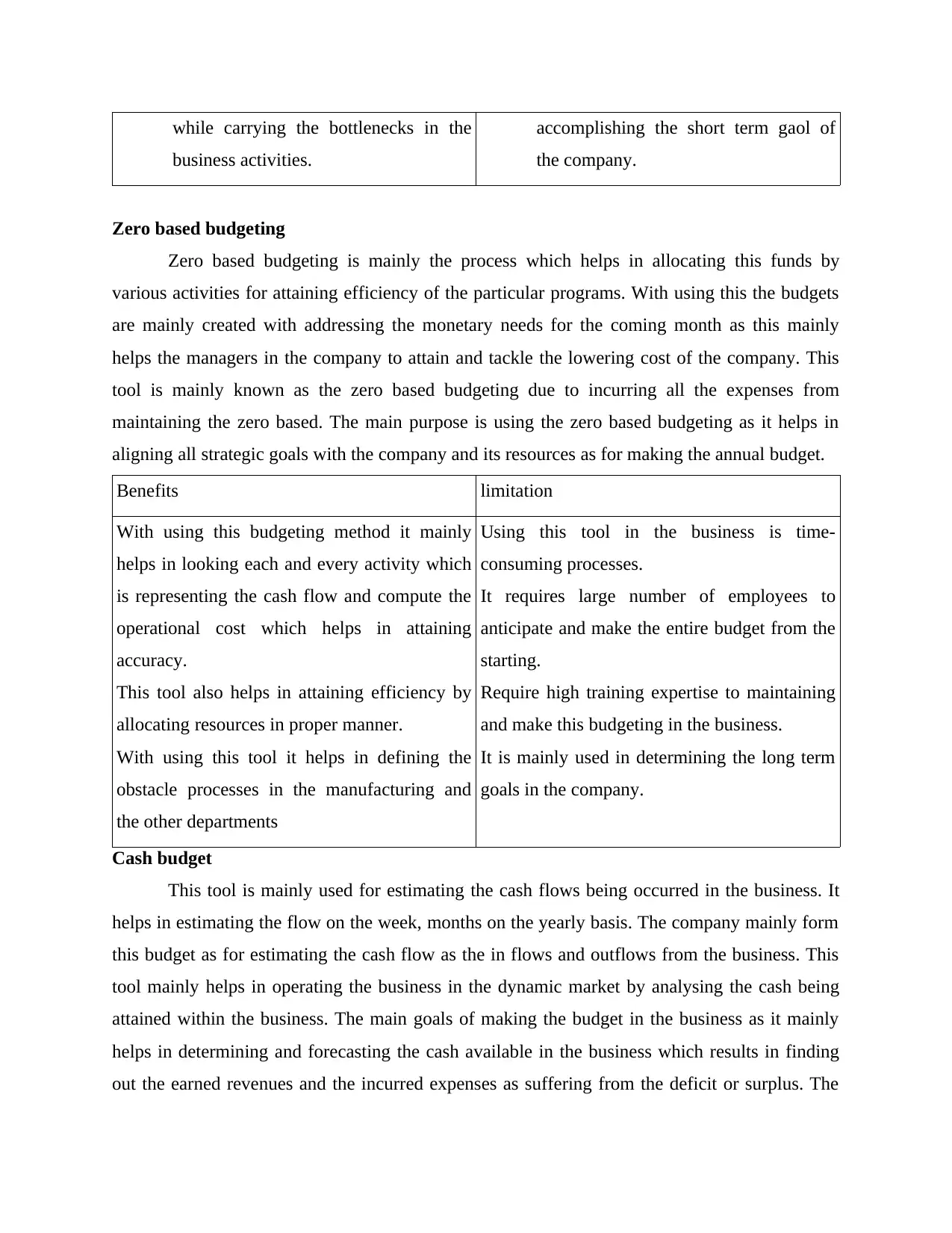
while carrying the bottlenecks in the
business activities.
accomplishing the short term gaol of
the company.
Zero based budgeting
Zero based budgeting is mainly the process which helps in allocating this funds by
various activities for attaining efficiency of the particular programs. With using this the budgets
are mainly created with addressing the monetary needs for the coming month as this mainly
helps the managers in the company to attain and tackle the lowering cost of the company. This
tool is mainly known as the zero based budgeting due to incurring all the expenses from
maintaining the zero based. The main purpose is using the zero based budgeting as it helps in
aligning all strategic goals with the company and its resources as for making the annual budget.
Benefits limitation
With using this budgeting method it mainly
helps in looking each and every activity which
is representing the cash flow and compute the
operational cost which helps in attaining
accuracy.
This tool also helps in attaining efficiency by
allocating resources in proper manner.
With using this tool it helps in defining the
obstacle processes in the manufacturing and
the other departments
Using this tool in the business is time-
consuming processes.
It requires large number of employees to
anticipate and make the entire budget from the
starting.
Require high training expertise to maintaining
and make this budgeting in the business.
It is mainly used in determining the long term
goals in the company.
Cash budget
This tool is mainly used for estimating the cash flows being occurred in the business. It
helps in estimating the flow on the week, months on the yearly basis. The company mainly form
this budget as for estimating the cash flow as the in flows and outflows from the business. This
tool mainly helps in operating the business in the dynamic market by analysing the cash being
attained within the business. The main goals of making the budget in the business as it mainly
helps in determining and forecasting the cash available in the business which results in finding
out the earned revenues and the incurred expenses as suffering from the deficit or surplus. The
business activities.
accomplishing the short term gaol of
the company.
Zero based budgeting
Zero based budgeting is mainly the process which helps in allocating this funds by
various activities for attaining efficiency of the particular programs. With using this the budgets
are mainly created with addressing the monetary needs for the coming month as this mainly
helps the managers in the company to attain and tackle the lowering cost of the company. This
tool is mainly known as the zero based budgeting due to incurring all the expenses from
maintaining the zero based. The main purpose is using the zero based budgeting as it helps in
aligning all strategic goals with the company and its resources as for making the annual budget.
Benefits limitation
With using this budgeting method it mainly
helps in looking each and every activity which
is representing the cash flow and compute the
operational cost which helps in attaining
accuracy.
This tool also helps in attaining efficiency by
allocating resources in proper manner.
With using this tool it helps in defining the
obstacle processes in the manufacturing and
the other departments
Using this tool in the business is time-
consuming processes.
It requires large number of employees to
anticipate and make the entire budget from the
starting.
Require high training expertise to maintaining
and make this budgeting in the business.
It is mainly used in determining the long term
goals in the company.
Cash budget
This tool is mainly used for estimating the cash flows being occurred in the business. It
helps in estimating the flow on the week, months on the yearly basis. The company mainly form
this budget as for estimating the cash flow as the in flows and outflows from the business. This
tool mainly helps in operating the business in the dynamic market by analysing the cash being
attained within the business. The main goals of making the budget in the business as it mainly
helps in determining and forecasting the cash available in the business which results in finding
out the earned revenues and the incurred expenses as suffering from the deficit or surplus. The
Paraphrase This Document
Need a fresh take? Get an instant paraphrase of this document with our AI Paraphraser
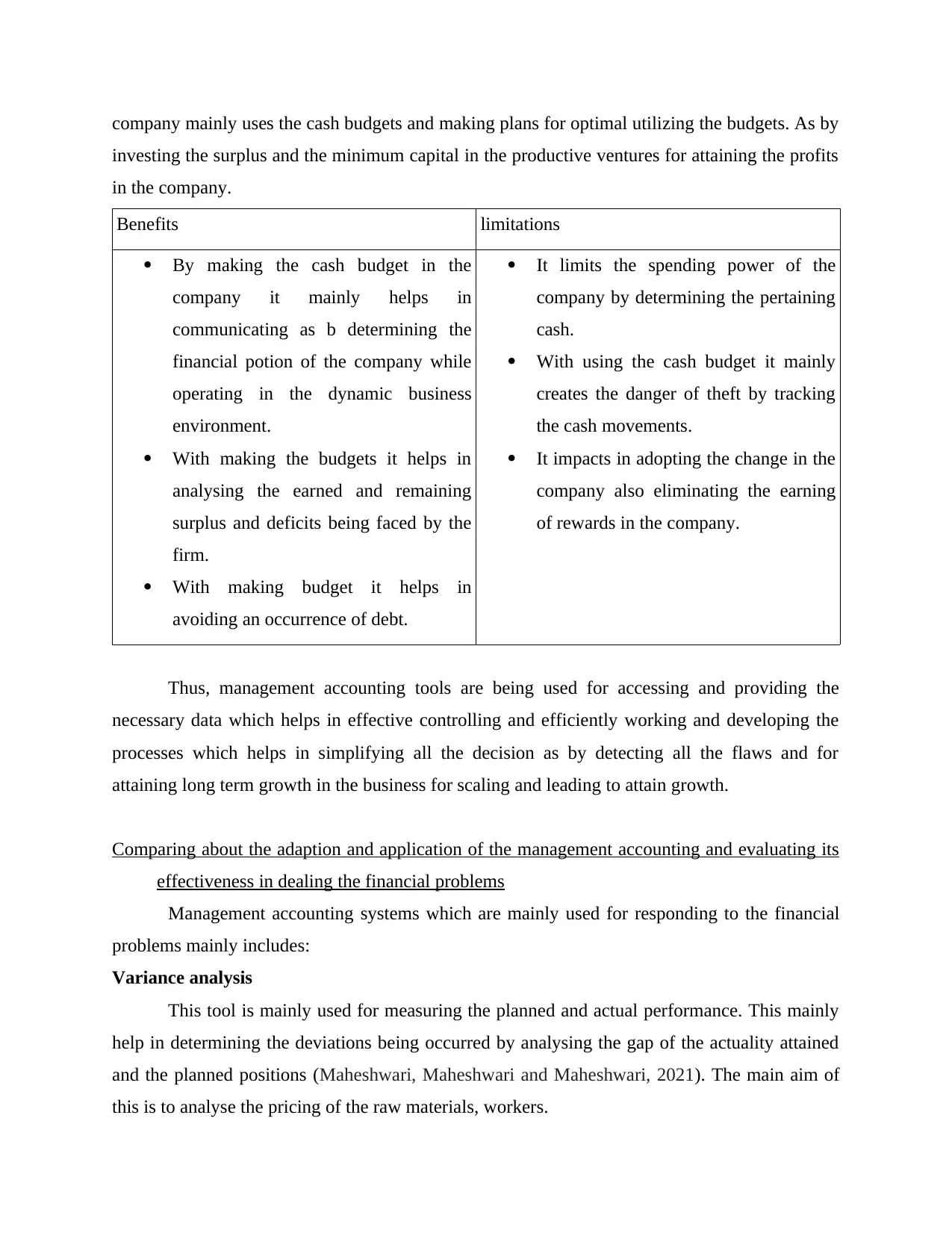
company mainly uses the cash budgets and making plans for optimal utilizing the budgets. As by
investing the surplus and the minimum capital in the productive ventures for attaining the profits
in the company.
Benefits limitations
By making the cash budget in the
company it mainly helps in
communicating as b determining the
financial potion of the company while
operating in the dynamic business
environment.
With making the budgets it helps in
analysing the earned and remaining
surplus and deficits being faced by the
firm.
With making budget it helps in
avoiding an occurrence of debt.
It limits the spending power of the
company by determining the pertaining
cash.
With using the cash budget it mainly
creates the danger of theft by tracking
the cash movements.
It impacts in adopting the change in the
company also eliminating the earning
of rewards in the company.
Thus, management accounting tools are being used for accessing and providing the
necessary data which helps in effective controlling and efficiently working and developing the
processes which helps in simplifying all the decision as by detecting all the flaws and for
attaining long term growth in the business for scaling and leading to attain growth.
Comparing about the adaption and application of the management accounting and evaluating its
effectiveness in dealing the financial problems
Management accounting systems which are mainly used for responding to the financial
problems mainly includes:
Variance analysis
This tool is mainly used for measuring the planned and actual performance. This mainly
help in determining the deviations being occurred by analysing the gap of the actuality attained
and the planned positions (Maheshwari, Maheshwari and Maheshwari, 2021). The main aim of
this is to analyse the pricing of the raw materials, workers.
investing the surplus and the minimum capital in the productive ventures for attaining the profits
in the company.
Benefits limitations
By making the cash budget in the
company it mainly helps in
communicating as b determining the
financial potion of the company while
operating in the dynamic business
environment.
With making the budgets it helps in
analysing the earned and remaining
surplus and deficits being faced by the
firm.
With making budget it helps in
avoiding an occurrence of debt.
It limits the spending power of the
company by determining the pertaining
cash.
With using the cash budget it mainly
creates the danger of theft by tracking
the cash movements.
It impacts in adopting the change in the
company also eliminating the earning
of rewards in the company.
Thus, management accounting tools are being used for accessing and providing the
necessary data which helps in effective controlling and efficiently working and developing the
processes which helps in simplifying all the decision as by detecting all the flaws and for
attaining long term growth in the business for scaling and leading to attain growth.
Comparing about the adaption and application of the management accounting and evaluating its
effectiveness in dealing the financial problems
Management accounting systems which are mainly used for responding to the financial
problems mainly includes:
Variance analysis
This tool is mainly used for measuring the planned and actual performance. This mainly
help in determining the deviations being occurred by analysing the gap of the actuality attained
and the planned positions (Maheshwari, Maheshwari and Maheshwari, 2021). The main aim of
this is to analyse the pricing of the raw materials, workers.
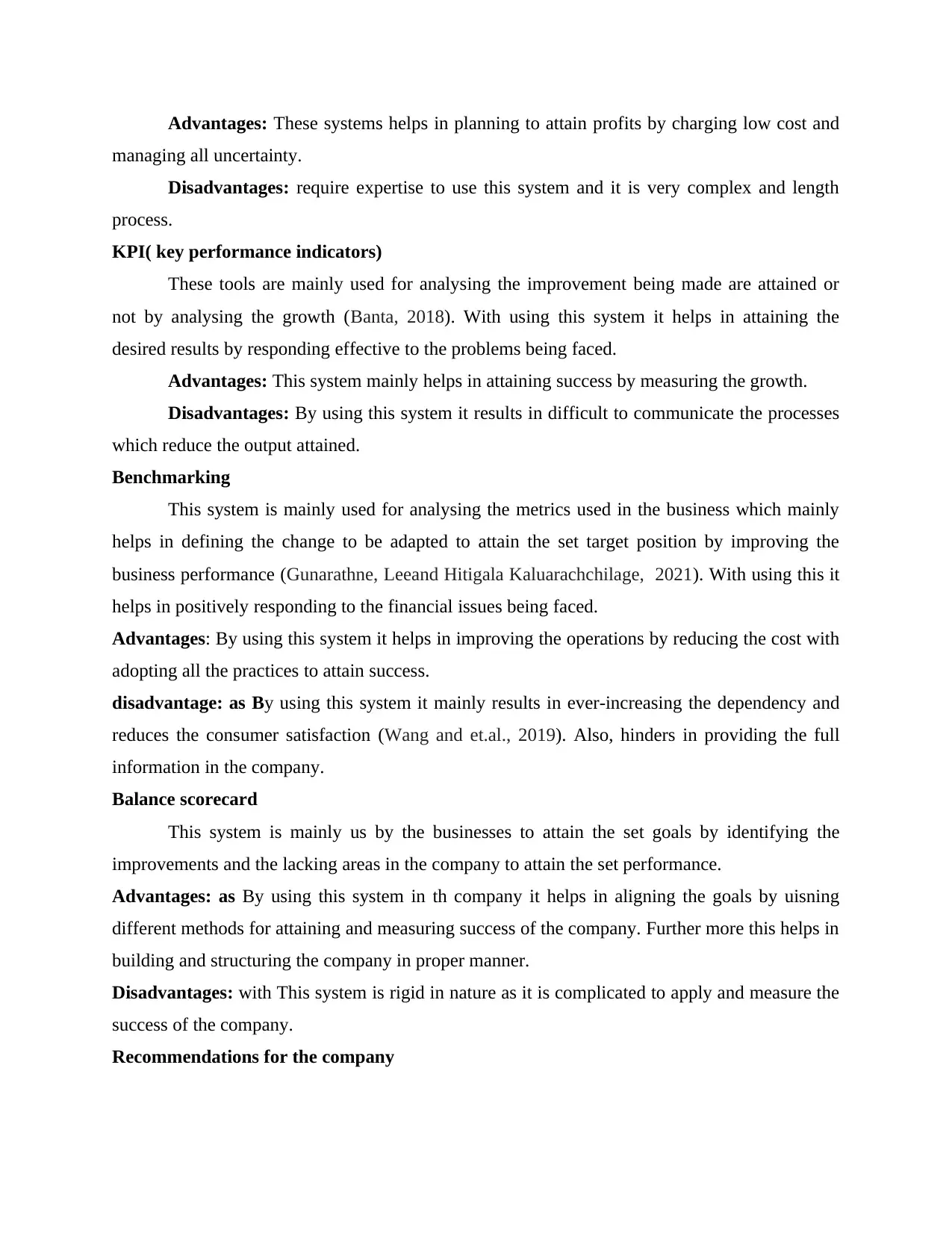
Advantages: These systems helps in planning to attain profits by charging low cost and
managing all uncertainty.
Disadvantages: require expertise to use this system and it is very complex and length
process.
KPI( key performance indicators)
These tools are mainly used for analysing the improvement being made are attained or
not by analysing the growth (Banta, 2018). With using this system it helps in attaining the
desired results by responding effective to the problems being faced.
Advantages: This system mainly helps in attaining success by measuring the growth.
Disadvantages: By using this system it results in difficult to communicate the processes
which reduce the output attained.
Benchmarking
This system is mainly used for analysing the metrics used in the business which mainly
helps in defining the change to be adapted to attain the set target position by improving the
business performance (Gunarathne, Leeand Hitigala Kaluarachchilage, 2021). With using this it
helps in positively responding to the financial issues being faced.
Advantages: By using this system it helps in improving the operations by reducing the cost with
adopting all the practices to attain success.
disadvantage: as By using this system it mainly results in ever-increasing the dependency and
reduces the consumer satisfaction (Wang and et.al., 2019). Also, hinders in providing the full
information in the company.
Balance scorecard
This system is mainly us by the businesses to attain the set goals by identifying the
improvements and the lacking areas in the company to attain the set performance.
Advantages: as By using this system in th company it helps in aligning the goals by uisning
different methods for attaining and measuring success of the company. Further more this helps in
building and structuring the company in proper manner.
Disadvantages: with This system is rigid in nature as it is complicated to apply and measure the
success of the company.
Recommendations for the company
managing all uncertainty.
Disadvantages: require expertise to use this system and it is very complex and length
process.
KPI( key performance indicators)
These tools are mainly used for analysing the improvement being made are attained or
not by analysing the growth (Banta, 2018). With using this system it helps in attaining the
desired results by responding effective to the problems being faced.
Advantages: This system mainly helps in attaining success by measuring the growth.
Disadvantages: By using this system it results in difficult to communicate the processes
which reduce the output attained.
Benchmarking
This system is mainly used for analysing the metrics used in the business which mainly
helps in defining the change to be adapted to attain the set target position by improving the
business performance (Gunarathne, Leeand Hitigala Kaluarachchilage, 2021). With using this it
helps in positively responding to the financial issues being faced.
Advantages: By using this system it helps in improving the operations by reducing the cost with
adopting all the practices to attain success.
disadvantage: as By using this system it mainly results in ever-increasing the dependency and
reduces the consumer satisfaction (Wang and et.al., 2019). Also, hinders in providing the full
information in the company.
Balance scorecard
This system is mainly us by the businesses to attain the set goals by identifying the
improvements and the lacking areas in the company to attain the set performance.
Advantages: as By using this system in th company it helps in aligning the goals by uisning
different methods for attaining and measuring success of the company. Further more this helps in
building and structuring the company in proper manner.
Disadvantages: with This system is rigid in nature as it is complicated to apply and measure the
success of the company.
Recommendations for the company
⊘ This is a preview!⊘
Do you want full access?
Subscribe today to unlock all pages.

Trusted by 1+ million students worldwide
1 out of 15
Related Documents
Your All-in-One AI-Powered Toolkit for Academic Success.
+13062052269
info@desklib.com
Available 24*7 on WhatsApp / Email
![[object Object]](/_next/static/media/star-bottom.7253800d.svg)
Unlock your academic potential
Copyright © 2020–2025 A2Z Services. All Rights Reserved. Developed and managed by ZUCOL.




